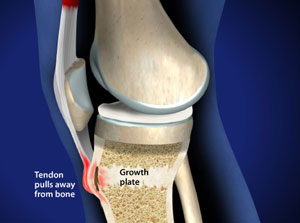Has your child been diagnosed with Osgood-Schlatter Disease? Are they having pain and/or inability to participate in sports or recreation? We can help!
What is Osgood-Schlatter Disease?
Osgood-Schlatter Disease (OSD) is a common cause of knee pain seen in growing adolescents. The term “disease” is misleading since this is not truly a “disease” but rather an overuse syndrome. The condition was named after two surgeons, Robert Bayley Osgood of the United States and Carl B. Schlatter of Switzerland who, independent of each other’s work, were the first physicians to describe it.
OSD is temporary, with children usually outgrowing it without any lingering issues. It is an inflammation of the area just below the knee where the tendon from the kneecap (patellar tendon) attaches to the shinbone (tibia).
Osgood-Schlatter disease most frequently occurs during growth spurts when bones, muscles, tendons, and other structures are changing at quick rate. Because physical activity places additional stress on bones and muscles, children who participate in athletics involving running and jumping sports are at an increased risk for OSD.

OSD typically affects children during their preadolescent years (girls aged 10 – 12 and boys aged 12- 14). At this stage of development, a child’s bones are typically growing faster than their muscles and tendons. As a result, the muscles and tendons have a tendency to become tight, creating stress on the bones they attach to. This imbalance stimulates the formation of a bony prominence or “bump” below the knee.
Although it is temporary, it can be quite painful. In some cases, it can result in an athlete not being able to participate in their sport(s) until the symptoms resolve.
Symptoms of OSD
Symptoms include pain and swelling over the tibial tubercle (area below the knee) which gets worse with activity and improves with rest. Usually, there is pain with kneeling and any activity in which the knee is bent or completely extended, such as running or squatting. In a majority of cases, only one knee is affected. There may be a “bump” noted below the knee.
How Can Physical Therapy Help?
Physical therapy can help speed up the healing process.
Physical therapy can help restore muscle flexibility and range of motion while reducing painful inflammation. When appropriate in the healing stages, your child will be assessed for proper biomechanics for normal gait and for sport specific motions such as running, jumping, acceleration, deceleration and directional changes to reduce the risk of reinjury and improve overall performance.
Call today to schedule a consultation!

